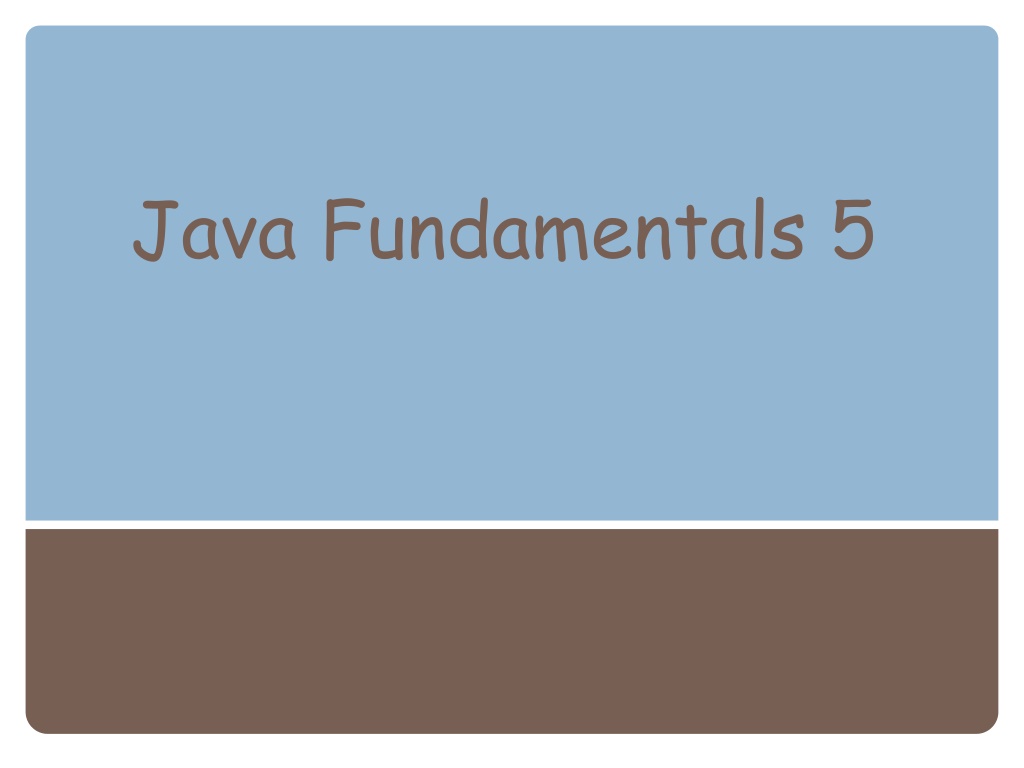
Parsing Numeric Strings in Java Programming
Learn how to convert numeric strings to integers, floats, and doubles in Java programming with the help of wrapper classes such as Integer, Float, and Double. Explore examples and formatting output using printf method for Java programming. Enhance your skills in handling numeric data efficiently.
Download Presentation

Please find below an Image/Link to download the presentation.
The content on the website is provided AS IS for your information and personal use only. It may not be sold, licensed, or shared on other websites without obtaining consent from the author. If you encounter any issues during the download, it is possible that the publisher has removed the file from their server.
You are allowed to download the files provided on this website for personal or commercial use, subject to the condition that they are used lawfully. All files are the property of their respective owners.
The content on the website is provided AS IS for your information and personal use only. It may not be sold, licensed, or shared on other websites without obtaining consent from the author.
E N D
Presentation Transcript
Parsing Numeric Strings Integer, Float, and Double are classes designed to convert a numeric string into a number. These classes are called wrapper classes. parseInt is a method of the classInteger, which converts a numeric integer string into a value of the type int. parseFloat is a method of the classFloat and is used to convert a numeric decimal string into an equivalent value of the type float. parseDouble is a method of the classDouble, which is used to convert a numeric decimal string into an equivalent value of the type double. Java Programming: From Problem Analysis to Program Design, Second Edition 2
Parsing Numeric Strings A string consisting of only integers or decimal numbers is called a numeric string. To convert a string consisting of an integer to a value of the type int, we use the following expression: Integer.parseInt("6723") = 6723 Integer.parseInt("-823") = -823 Integer.parseInt(strExpression) Example: Java Programming: From Problem Analysis to Program Design, Second Edition 3
Parsing Numeric Strings To convert a string consisting of a decimal number to a value of the type float, we use the following expression: Float.parseFloat(strExpression) Example: Float.parseFloat("34.56") = 34.56 Float.parseFloat("-542.97") = -542.97 To convert a string consisting of a decimal number to a value of the type double, we use the following expression: Double.parseDouble(strExpression) Example: Double.parseDouble("345.78") = 345.78 Double.parseDouble("-782.873") = -782.873 Java Programming: From Problem Analysis to Program Design, Second Edition 4
Formatting Output with printf The syntax to use the method printf to produce output on the standard output device is: System.out.printf(formatString); or System.out.printf(formatString,argumentList) ; formatString is a string specifying the format of the output. argumentList is a list of arguments that consists of constant values, variables, or expressions. If there is more than one argument in argumentList, the arguments are separated with commas. Java Programming: From Problem Analysis to Program Design, Second Edition 5
Formatting Output with printf System.out.printf("Hello there!"); Consists of only the format string and the statement: System.out.printf("There are %.2f inches in %d centimeters.%n", centimeters / 2.54, centimeters); Consists of both the format string and argumentList. %.2f and %d are called format specifiers. By default, there is a one-to-one correspondence between format specifiers and the arguments in argumentList. The first format specifier, %.2f, is matched with the first argument, which is the expression centimeters / 2.54. Java Programming: From Problem Analysis to Program Design, Second Edition 6
Formatting Output with printf The second format specifier, %d, is matched with the second argument, which is centimeters. The format specifier %n positions the insertion point at the beginning of the next line. If centimeters = 150 150/2.54 =59.05511811023 The o/p would be : There are 59.06 inches in 150 centimeters The output of a printf statement is right-justified by default. To force the output to be left-justified, negative column widths may be used. Java Programming: From Problem Analysis to Program Design, Second Edition 7
Example1 public class Example3_6 { public static void main (String[] args) { int num = 763; double x = 658.75; String str = "Java Program."; System.out.println("123456789012345678901234567890"); System.out.printf ( "%5d%7.2f%15s%n", num, x, str); System.out.printf ("%15s%6d%9.2f %n", str, num, x); } } Java Programming: From Problem Analysis to Program Design, Second Edition 8
Example1 Sample run : 123456789012345678901234567890 763 658.75 Java Program. Java Program. 763 658.75 Java Programming: From Problem Analysis to Program Design, Second Edition 9
Example2 public class Example3_7 { public static void main (String[] args) { int num = 763; double x = 658.75; String str = "Java Program."; System.out.println("123456789012345678901234567890"); System.out.printf("%-5d%-7.2f%-15s ***%n", num, x, str); System.out.printf("%-15s%-6d%- 9.2f ***%n", str, num, x); } } Java Programming: From Problem Analysis to Program Design, Second Edition 10
Example2 Sample Run : 123456789012345678901234567890 763 658.75 Java Program. *** Java Program. 763 658.75 *** Java Programming: From Problem Analysis to Program Design, Second Edition 11
Formatting Output with printf Java Programming: From Problem Analysis to Program Design, Second Edition 12
Commonly Used Escape Sequences 13 Java Programming: From Problem Analysis to Program Design, Second Edition
